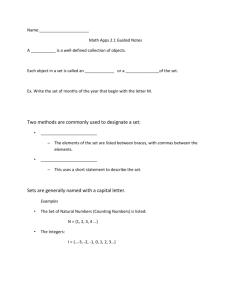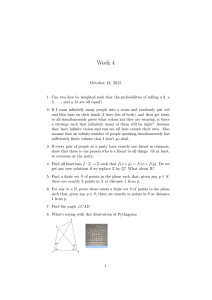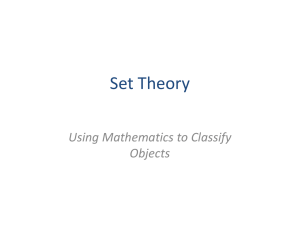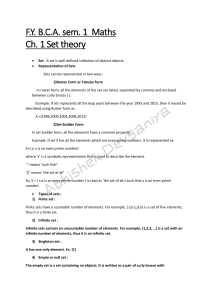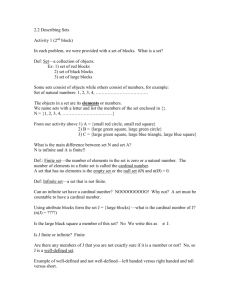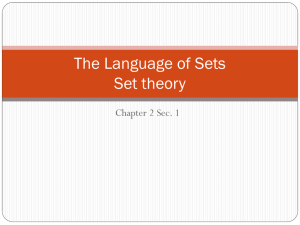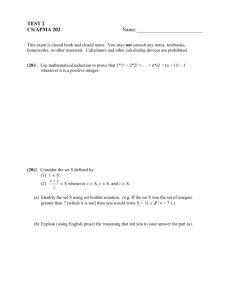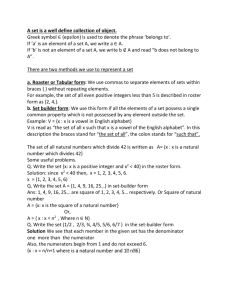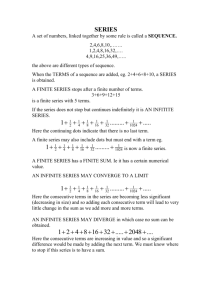section 2.1 class notes
advertisement
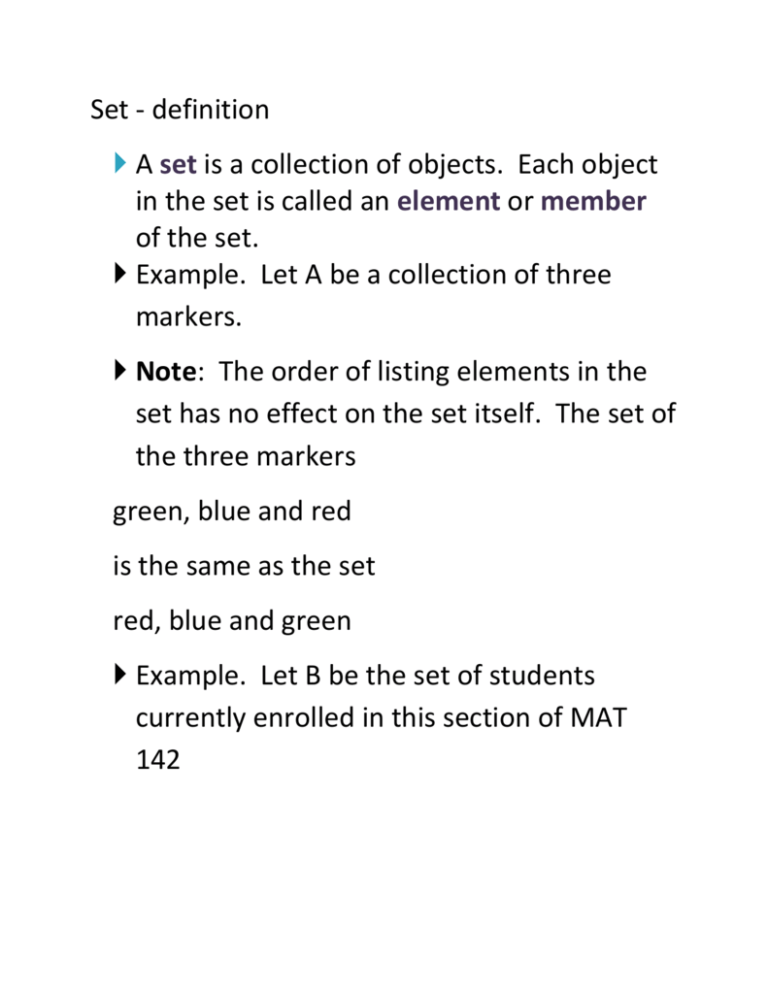
Set - definition
A set is a collection of objects. Each object
in the set is called an element or member
of the set.
Example. Let A be a collection of three
markers.
Note: The order of listing elements in the
set has no effect on the set itself. The set of
the three markers
green, blue and red
is the same as the set
red, blue and green
Example. Let B be the set of students
currently enrolled in this section of MAT
142
A set should be well-defined.
A set is well-defined if any informed objective
person can decide if a given element is in the
set or not.
Which of the following sets are well-defined?
(help for #13 – 18 section 2.1)
1) A is the set of goofy dogs.
2) B is the set of GCC students whose gpa is 3.0 or
greater.
3) C is the set of good GCC students.
4) D is the set of numbers whose square is 16.
Finite Sets versus Infinite Sets
A set is finite if it is possible, given enough
time, to write down every element in the
set.
A set is infinite if it is not finite.
Example. The set {1, 2, 3, …, 1000000000000}
is finite. It wouldn’t be fun to actually write
every element in this set, but it is possible given
enough time.
◦ Note: The three periods in this definition
are called ellipses and mean that you
should continue with the established
pattern.
◦ Note: The curly braces in this definition are
called set braces.
Example. The set {1, 2, 3, …} is infinite.
Determine whether each set is finite or infinite
(19-24 section 2.1)
1) The set of multiples of 3 between 1 and
100
2) The set of fractions between 0 and 1
Two Special Sets
The set of counting numbers 1, 2, 3, 4, 5, … is
called the set of Natural Numbers. The set of
natural numbers is denoted N.
The set containing no elements is called the
empty set, or null set. The null set is denoted
by { }, or by the small Greek letter phi, ∅.
More Notation
5 ∈ A means “5 is an element of the set A.”
When you see the notation 5 ∈ A, it means that
5 will be in the list if you make a list of all of the
members of set A.
A = {1,2,3,4,5} it would be correct to write 5 ∈ A
5 ∈ A (I read this as 5 is an element of A)
Also since 6 is not in the list of all of the elements
of A, we can write
6∉A
(I read this as 6 is not an element of A)
Three ways of defining a set
I. (Word) Description: Let A be the set of
natural numbers less than 3.
II. Set-Builder Form:
◦ A = {x | x is a natural number, x<3}
◦ Or equivalently
◦ A = {x | x ∈ 𝑁, x<3}
◦ In this notation the curly braces are set
braces.
◦ x is a variable, meaning it may take on a
variety of values.
◦ The vertical bar stands for the phrase “with
the property that.”
◦ A comma in this context means “and.”
III. Roster, or List Form:
◦ A = { 1, 2}
Examples
Write sets in roster form, call the set B if no
name is given. (25 – 34 section 2.1)
1) The set of natural numbers between 5 and 10
2) The set of even natural numbers greater than
4
3) B = { k | 2(k+1)=6 }
4) C = { m | m is a natural number, m < 1}
5) D = { m ∈ 𝑁, 2 < m <9}
Write the sets in set-builder form.
(43 – 50 section 2.1)
1) D = {2, 3, 4, …}
2) A = {1,2,3,4,5}
3) E = set of even natural numbers
Write a (word) description of each set (51-58
section 2.1)
1) D = {2, 3, 4, …}
2) A = {1,2,3,4,5}
3) D = {Bashful, Doc, Dopey, Grumpy,
Happy, Sleepy, Sneezy}
Definition of Set Equality
Two sets are equal if they contain precisely the
same elements.
The Cardinal Number of a finite set A is the
number of elements of A.
The cardinal number of a set A is denoted n(A).
1) Find the cardinal number of the following
set A.
◦ A = {x | x ∈ N, 2 < x < 10}
Set Equivalence for Finite Sets
Finite set A is equivalent to set B if n(A) = n(B).
If two sets are equivalent it means that they have
the same number of elements. These sets are
equivalent, but not equal A={1,2,3} and B={a, b, c}.
(75 – 78 section 2.1)
1)
Find n(A) where A = {1,3,5}
2)
Find n(B) where B = {a, c, e, o, v}
Determine whether the sets A and B are equal,
equivalent, both or neither
(79 – 84 section 2.1)
1)
A = {a,b,c} B = {c,b,a}
2)
A = {0,1,2,3,4} B = {a,b,c,d,e}
3)
A = {1,2,3} B = {4,5,6,7}
